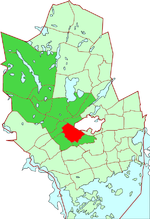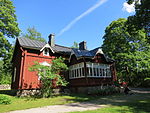Espoo Cathedral

Espoo Cathedral (Finnish: Espoon tuomiokirkko, Swedish: Esbo domkyrka) is a medieval stone church in Espoo, Finland, and the seat of the Diocese of Espoo of the Evangelical Lutheran Church of Finland. The cathedral is located in the district of Espoon keskus, near the Espoonjoki river. The oldest parts of the church were completed in the 1480s and it is thus the oldest preserved building in the city. The church became a cathedral in 2004 after the Diocese of Espoo was split off from the Diocese of Helsinki. The cathedral grounds include a graveyard, a vicarage and a parish hall completed in 1995. In addition to being the seat of the Diocese of Espoo, it serves as the church for the Espoo Cathedral Parish and hosts various concerts and other events including the "Organ Night and Aria" concert series.
Excerpt from the Wikipedia article Espoo Cathedral (License: CC BY-SA 3.0, Authors, Images).Espoo Cathedral
Kirkkopuisto, Espoo Espoon keskus (Vanha-Espoo)
Geographical coordinates (GPS) Address Website External links Nearby Places Show on map
Geographical coordinates (GPS)
| Latitude | Longitude |
|---|---|
| N 60.209166666667 ° | E 24.652222222222 ° |
Address
Espoon tuomiokirkko (Espoon kirkko;Espoon vanha kirkko;Espoon harmaakivikirkko;Espoon vanha kivikirkko)
Kirkkopuisto 5
02770 Espoo, Espoon keskus (Vanha-Espoo)
Finland
Open on Google Maps






